
By Dave Lovalvo, ROV Operations Coordinator - Global Foundation for Ocean Exploration
October 14, 2019
What lies beneath ‘the ocean’ is the fundamental question this expedition on NOAA Ship Reuben Lasker is working to address. This log is a slight twist on that idea. This is about the anticipated as well as the sometimes unexpected engineering challenges that we discover every time we prepare for an expedition, particularly when we are doing remotely operated vehicle (ROV) work on a vessel that we have never used before.
Projects are almost never simple and straightforward. The ROV team always finds surprises lurking beneath the surface when determining the best way to integrate ship and ROV operations. Those preparations must start months in advance of any cruise. How thorough a job our ROV engineers do at finding those surprises and mitigating the challenges can help make or break expedition success long before the ship ever leaves the dock.
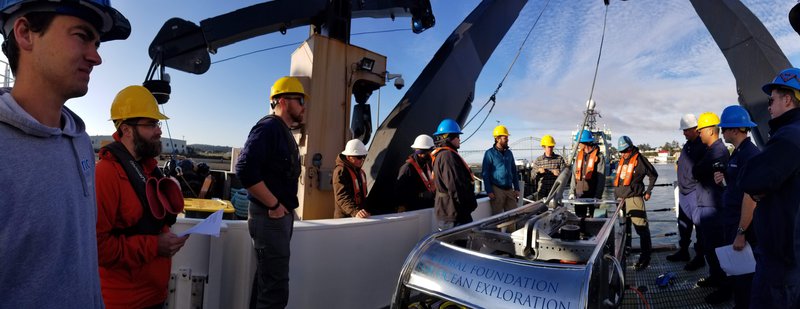
ROV Discussion: One of the most critical pre-cruise tasks was to have ship and ROV personnel collectively diagram, discuss, and practice ROV launch and recovery. Image courtesy of Roland Brian, GFOE. Download larger version (jpg, 949 KB).
Since around 2010, the ROV engineering team with the Global Foundation for Ocean Exploration (GFOE) has largely been preparing for and executing cruises onboard NOAA Ship Okeanos Explorer. Even though that vessel is explicitly designed and outfitted to support ROV operations, we still always have unexpected and most often expensive challenges that pop up.
This cruise is completely different in that NOAA originally designed and outfitted the vessel, Reuben Lasker, to support fisheries science and acoustics work. Though scientists have conducted some small, relatively simple ROV work from her in the past, Lasker was not anticipated to be a dedicated ROV platform. More importantly, the ship had no significant onboard infrastructure to support ROV operations, which had to be taken into account when budgeting for this project.
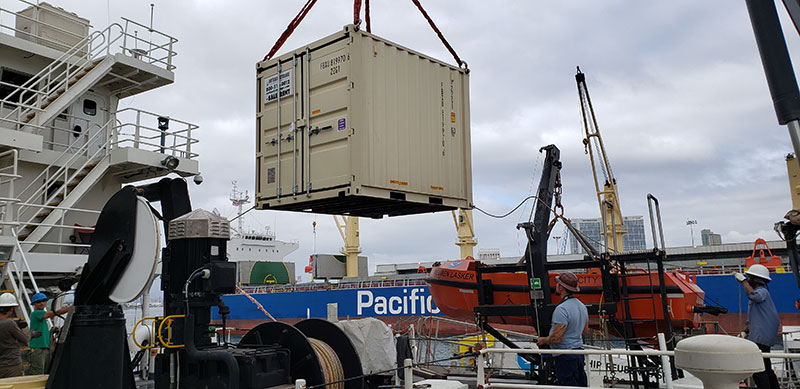
Lasker Loading: Ship’s crew loaded a subset of expedition equipment onto NOAA Ship Reuben Lasker in San Diego, California. Image courtesy of LT Dave Wang, NOAA. Download image (jpg, 4.1 MB).
There are advantages to using a “vessel of opportunity”, but for the most part, it’s related to proximity to the area of exploration desired. Long transits to and from research can be very expensive. When using a vessel of opportunity, we need to use a more portable, or what is sometimes referred to as a ‘fly-away,’ ROV system. This requires us to anticipate, procure, pack, and ship everything necessary to operate and troubleshoot the system before we get onboard. In many cases, we must also work with ship personnel and port engineers long before we arrive to design, build, modify and install key ship-specific equipment that will be essential for supporting the cruise. This is not so easy when the ship has other missions to perform in tandem with this work.
However, in the end, when the cruise is finally slated to begin, we meet our equipment at the ship and spend several days unpacking gear, moving equipment, modifying systems, and finally integrating the remaining equipment with the ship. When the project is over, we remove all the equipment we integrated that will not remain as part of the ship's future compliment and ship it all back to our home base. As you can imagine, the difference in work required to mobilize a project using an ROV dedicated to a ship versus a fly-away ROV system can be significant, particularly when you add telepresence to the mix.
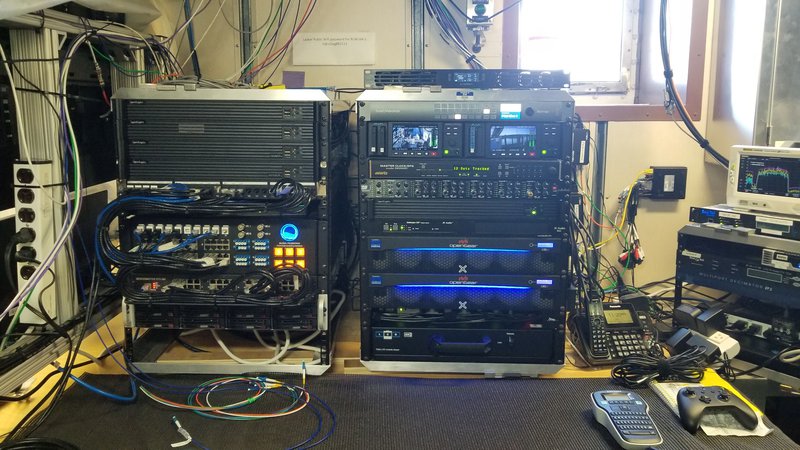
Telepresence Set up: Though expedition mobilization was primarily in Newport Oregon, a subset of GFOE personnel arrived at the ship earlier in San Diego, California, to get a jumpstart on preparations. One of the big items that GFOE personnel worked on during the San Diego to Newport transit was setting up the telepresence system. Image courtesy of Roland Brian, GFOE. Download larger version (jpg, 4.0 MB).
There were a number of key issues that GFOE engineers worked with NOAA personnel to address and troubleshoot in the months - and sometimes days - before this cruise started. Below are a few of some of the bigger ones that kept us up at night(s) before this cruise:
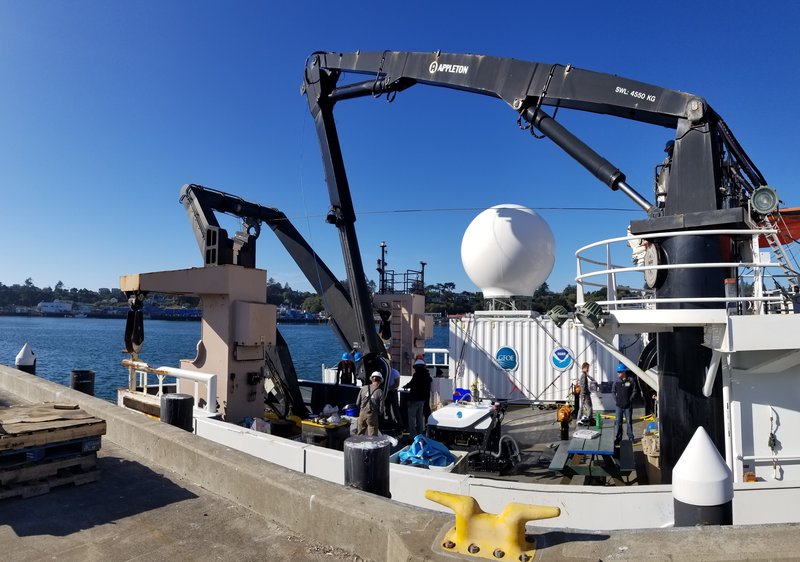
VSAT Antenna: Streaming of the live video is possible because of the satellite antenna system under the white dome. The system packs up into the container it is mounted on. Image courtesy of Roland Brian, GFOE. Download larger version (jpg, 2.6 MB).
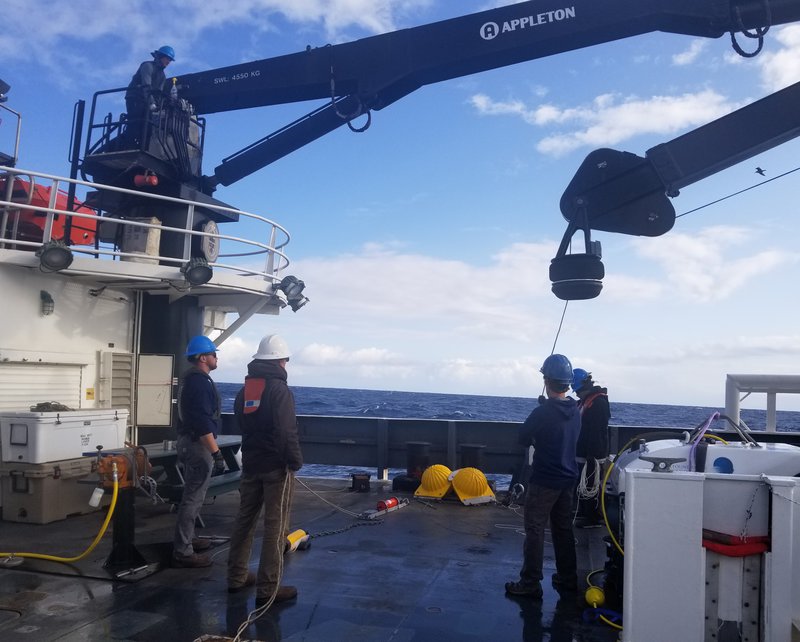
Swing Arrestor: The round attachment at the end of the crane prevents the ROV from widely swinging back and forth with the movement of the ship. Image courtesy of Roland Brian, GFOE. Download larger version (jpg, 2.9 MB).
The entire expedition team includes people that work to support ship, science, AUV, and ROV operations. As you can imagine, there is an incredible amount of communication and coordination required among all expedition team members both in advance and during an expedition to best ensure success.
If you are part of a good team, then you have a chance at dealing with the unexpected! So far so good. I think we are ready for whatever lies beneath.